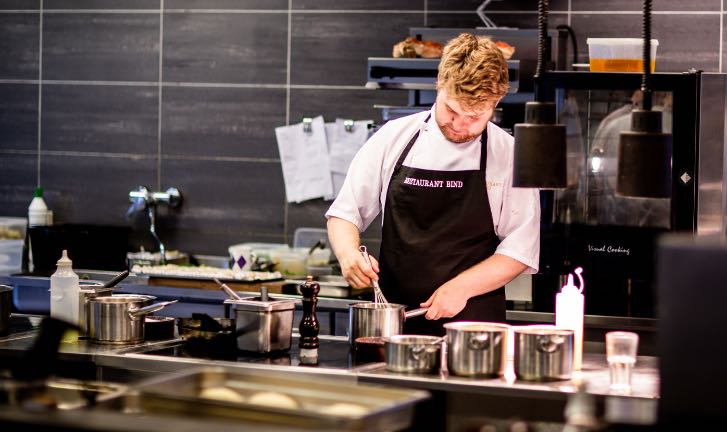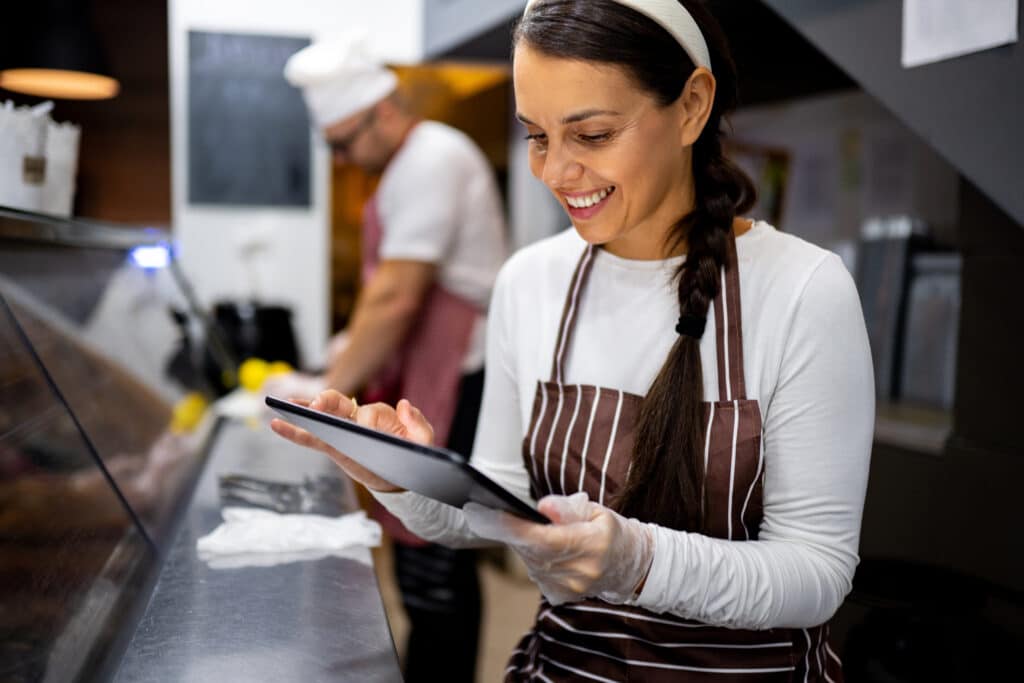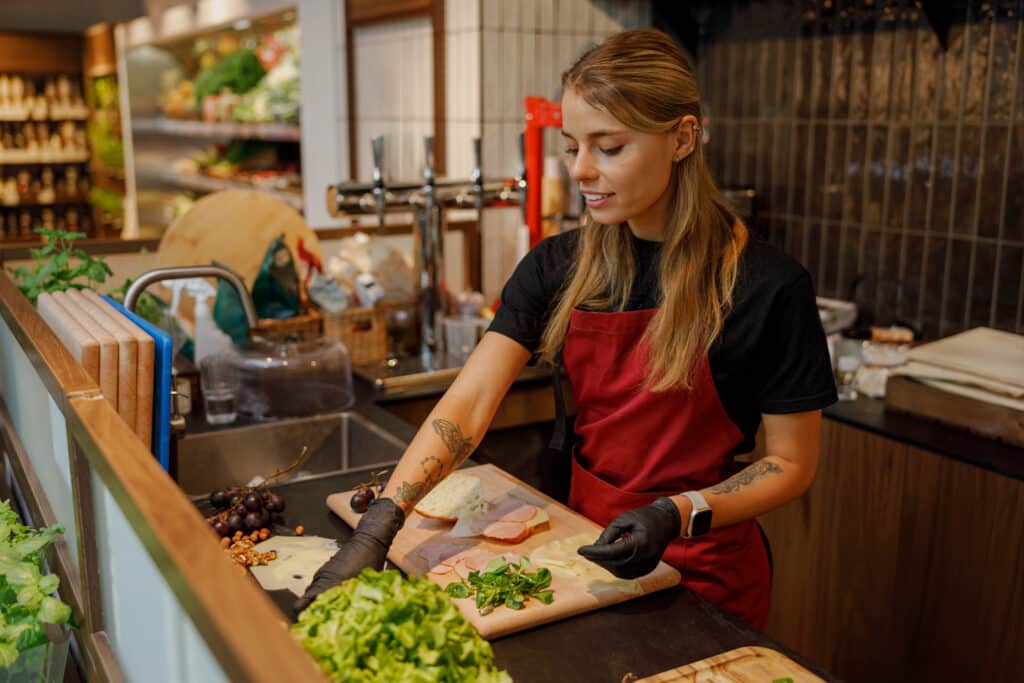Although many restrictions on restaurants are starting to lift, COVID-19 has permanently changed the landscape of the restaurant industry. First, stay-at-home orders and dining restrictions prompted restaurants to focus on takeout and delivery. Now, the pandemic has impacted what the dining experience looks like, what guests want, and most significantly—the demand for delivery and takeout.
The possibilities for a successful restaurant business model have evolved. As a prominent example, virtual kitchens existed before the pandemic, but the last year has skyrocketed the growth of this new kind of establishment.
As restaurants adapt to how customer dining preferences have changed, ghost kitchens are now more popular and quite often more profitable. If you’re considering the idea of a virtual kitchen for your restaurant group, you need to understand the details of the business model.
Here, we’ll explore questions about ghost kitchen costs, benefits, and financial projections so you can better understand whether it’s a good fit for your restaurant group.
What is a virtual kitchen?
A virtual kitchen, also commonly known as a ghost kitchen, is a slimmed-down version of a restaurant that cuts costs like real estate and labor to focus purely on off-premise sales channels.
In simplest terms, a ghost kitchen is usually delivery only, with some offering takeout options. The process for the customer is essentially the same as it would be for ordering from any restaurant: customers contact the business through a third-party delivery app, the restaurant’s website or app, or the phone.
In fact, many customers don’t realize that they are ordering from a ghost kitchen. However, on the restaurant end, there is no storefront, usually no possibility of walk-in business, and no front-of-house staff interacting in person with customers.
Types of virtual kitchens
All virtual kitchens operate out of commercial kitchen spaces, under the same licensing and food safety standards as restaurants. However, since there aren’t customers entering the space in the delivery-only business models, virtual kitchens look different from full-service restaurants.
For example, many virtual kitchens operate out of a commissary or shared kitchen space. Some spaces are built specifically for ghost kitchens, with appliances or tools that are ready for a business to rent. Some established restaurant groups may also build their own specific, dedicated kitchen.
Another potential type of virtual kitchen is a pop-up or incubator kitchen. This is a smaller segment of the industry that is aimed toward supporting new concepts or small restaurant groups expanding their delivery options. These spaces may be a separate part of a regular brick and mortar restaurant, devoted only to fulfilling delivery orders.
No matter what kind of ghost kitchen, the location is usually centered where there is a heavy demand for delivery, so it is easy for the restaurant to tap into an active market.
The rise of delivery as a consumer trend
COVID-19 may have spurred a food delivery industry boom, but the data indicates that delivery and takeout won’t disappear even once dining can return to pre-pandemic norms.
The 2021 State of the Restaurant Industry report by the National Restaurant Association says that about half of full-service restaurant operators had dedicated more resources to off-premise business during the COVID-19 pandemic. And now, in 2021, 53 percent of adults report that “purchasing takeout or delivery food is essential to the way they live.”
In addition, according to the report, a year after the pandemic started, “6 in 10 adults say they’re more likely to get their food delivered than they were before the outbreak. For millennials, it’s 71%.”
QSR Magazine summarizes this data, indicating that the shift has held true across generations, with how off-premise “will undeniably decrease as dine-in options emerge, but it’s safe to assume it won’t ever go back to where it was, either.”
In the face of changing consumer behavior, but with an eye on optimizing restaurant food cost, restaurant owners and operators are looking toward new types of business models.
Why consider a virtual kitchen?
For existing restaurant groups, why consider adding a ghost kitchen as a new revenue stream? Here are some benefits for restaurant groups.
Expand Delivery Radius with Existing Menu Items
Since food delivery has a limited geographic range, the success of your virtual kitchen depends heavily on the demand in your local area.
Say you have a brick and mortar restaurant located in a retail area that gets a ton of walk-in lunch guests from surrounding office buildings during the weekdays. This may be a great location when there is foot traffic, but with COVID-19 prompting work from home arrangements, your business may have been impacted. And if your restaurant location isn’t near where many people live, your delivery potential is limited.
Or even if your business is thriving in a residential area with many delivery orders, you are limited in expanding your delivery radius. You can adjust your menu to focus on high profit margin items that travel well, but eventually you will face limitations. Long delivery times may not be financially feasible, or you may start to have issues with food temperature, quality, and taste.
Virtual kitchens offer the chance to expand your delivery range with strategic real estate choices. It is a chance to move your food delivery operations to where customers are located.
New location considerations can also potentially allow you to move into a cheaper real estate option. If you don’t need to worry about a storefront, extra parking, or other factors, you can be more flexible in pursuing locations that are less costly.
Introduce New Menu Items
If you already have an established concept, a ghost kitchen can be a tool for you to adapt to shifting trends and explore new revenue streams.
First, as we’ll explore below, you can leverage a lower overall labor cost to experiment with changing food costs and menu engineering strategies. A ghost kitchen can be a more friendly environment for generating sales data about new menu items that you can analyze for other menu changes.
Most importantly, with a ghost kitchen, you have more flexibility in changing your menu. You can control your digital menu in near-live time, which allows you to experiment in a way that customer-facing concepts cannot. For example, you can remove an item midday because of low inventory, or add a special mid-service. Overall, you have more flexibility to leverage sales data and make smart adjustments quickly.
Introduce a New Concept Before Opening a New Restaurant
You can also use your ghost kitchen as a launchpad for a new concept for your restaurant group. The virtual kitchen can be an opportunity to experiment with something at a lower cost, and with less risk, compared to committing to opening a full physical location.
Maybe it wasn’t financially viable to open a full-service concept in a certain part of town, or you weren’t sure if your recipe cost analysis for a new type of cuisine would be profitable enough with a certain audience. Without the cost of a full restaurant buildout, including front-of-house equipment and additional licenses, you can test your concept before committing to a brick and mortar location.
Adding a New Sales Channel
Virtual kitchens represent a new sales channel for your restaurant group, because you are increasing your capacity to meet the growing demand for online delivery and takeout. Whether you set up an in-house delivery system or use a third-party food delivery service, you can access a wider audience because of a new geographic location.
In addition, a delivery-focused operation allows you to expand your sales channels because you can operate with more volume. Full-service, dine-in restaurants need to serve walk-in guests and obey occupancy limits.
However, the sales of a virtual kitchen aren’t limited by the number of table turns you can do in a night. A ghost kitchen doesn’t have a finite number of seats. Without dine-in customers, all you need to consider is how many delivery or takeout orders you can fulfill, given your space and labor constraints.
When choosing a location for a ghost kitchen, you may want to consider focusing on an area where you already have a base of customers. If you do want to break into a new market, to make this a successful new sales channel, be prepared to budget for marketing and promotion online.
Increasing Profits
Finally, ghost kitchens offer the opportunity to help you optimize your restaurant profit margin.
Without a full buildout, dining room and guest services, virtual kitchens offer the benefit of being relatively quick to set up.
In addition, without a storefront, the cost of real estate is likely to be a bit lower. Although you certainly want to be located in a good delivery location, the exact address for a virtual kitchen isn’t as important as it is for a full-service restaurant. You aren’t relying on walk-in customers, or even visibility of signage, so you have more flexibility in choosing locations besides a highly visible strip of a retail district.
Without the need for a full front-of-house service staff, your labor overhead looks significantly different. Your workflow is based solely on delivery orders, making it easier for your staff to focus on one centralized task rather than trying to juggle multiple channels of dine-in, takeout, and delivery.
Food trucks and virtual kitchens
No discussion about virtual kitchens would be complete without mentioning food trucks. Whether you own a food truck or are considering operating one, it is another alternative revenue stream that you can consider adding to your restaurant group.
In many ways, food trucks can operate similarly to ghost kitchens, blurring the line between the two. Without the cost of a brick and mortar restaurant buildout, you have more flexibility trying out new menus, concepts, and food and labor costs. If you are considering opening up a virtual kitchen, a food truck can offer an opportunity to test out the profitability of delivery, before you commit to a full virtual kitchen.
Tracking virtual kitchen profitability
Profitability for a virtual kitchen and profitability for a brick and mortar restaurant are calculated in the same way, but the numbers may look quite different.
Virtual kitchens likely have no front-of-house labor cost and a lower overhead for real estate. However, with ghost kitchens, you also have higher delivery costs, whether you are running delivery in-house or through a third-party app.
To create accurate financial projections for your ghost kitchen, you need to ensure that you are understanding your delivery costs. Ensure that your point of sale (POS) system, your restaurant accounting system, and your delivery systems are fully integrated to track the data you need.
Profit margin varies between different order modes for your restaurant, so also consider choosing a restaurant management system that is able to accurately track delivery sales and expenses to drive your operational decisions.
Finally, if you already offer delivery with an existing restaurant, your ghost kitchen should also be tracked as a separate location. Delivery profitability between a brick and mortar restaurant and a virtual kitchen within the same restaurant group will still look much different, since the underlying business models have significantly different costs.
Real-world virtual kitchen success
If you’re considering adding a virtual kitchen to your restaurant group, looking at case studies from the restaurant industry can show you how other restaurants are approaching the challenge.
For example, Wow Bao is a Restaurant365 customer that has created new partnerships in different cities that utilize a space’s equipment and personnel to serve prepared Wow Bao staples. This menu is promoted through third-party delivery providers, creating a new alternative stream of revenue for the restaurant group.
Another Restaurant365 customer, Great NH Restaurants (operating T-BONES, CJ’s Great West Grill, Copper Door) also launched a ghost kitchen this past year. The kitchen DingDongDeliver.com serves popular menu items from the brand and some packaged dinner options.
According to Great NH Restaurants’ CEO Tom Boucher. “So far, it’s been very well received. With very low rent and no front-of-the-house labor (wait staff, host, manager) that has helped with return on sales. We will be branching out and marketing in our restaurants where guests can order and pick up directly at the restaurant on a specific day of the week. We will reach 10X more potential customers this way,” said Boucher.
Conclusion
Ghost kitchens represent a new, exciting frontier in the restaurant industry. While there is no one-size-fits-all model for restaurant group success, virtual kitchens offer a potential new stream of income with limited overhead. As restaurants adapt to changing consumer behavior driven by sales data and increased delivery services, ghost kitchens may be here to stay.
If you are considering what a virtual kitchen would look like for your restaurant group, and you would like to easily track data and gain insight into your operations, consider a comprehensive, restaurant-specific management solution. Restaurant365 incorporates restaurant accounting software and restaurant operations software into an all-in-one, cloud-based platform. It includes tools for financial reporting, operational reporting, inventory control, scheduling, and more. For more information, schedule a free demo.



